Brewing Beer with Brown Malt
Published: August 5, 2025 at 2:19:21 PM UTC
Specialty malts can transform your beer's flavor. Brown malt, made by roasting barley, offers a unique taste. It's known for its nutty and toasted notes, with hints of coffee and light chocolate. This malt brings depth and complexity to beers like pale ales and stouts. Its rich flavor is perfect for brewers aiming to create distinctive brews.
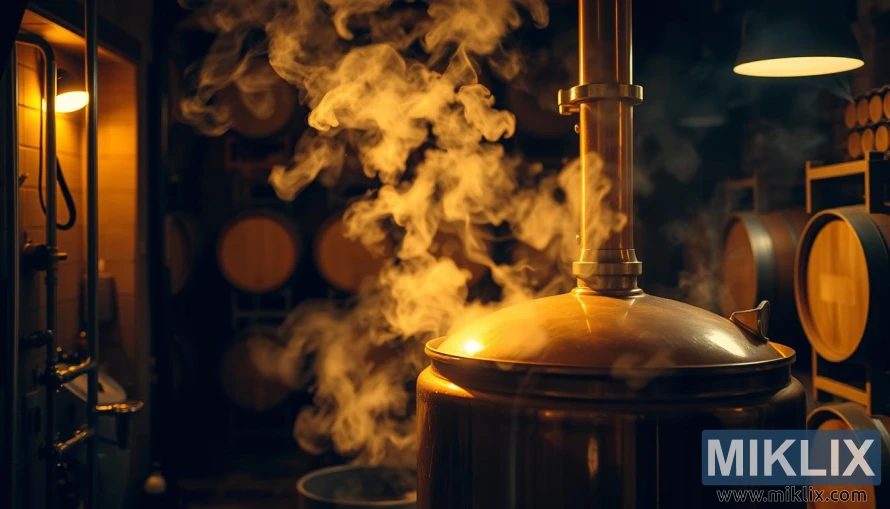
Key Takeaways
- Using brown malt in brewing introduces nutty and toasted flavors.
- Brown malt is versatile and can be used in a variety of beer styles.
- The malt's flavor profile includes hints of coffee and light chocolate.
- Brewing with brown malt can add complexity to your beer.
- It's a great choice for brewers looking to create unique beers.
Understanding Brown Malt's Unique Character
Brown malt is a specialty malt that brings a rich, complex character to beer. Its flavor profile is marked by nutty, toasted notes, with hints of coffee and chocolate. This makes it a favorite among brewers.
The aroma of brown malt is distinct, with a sweet, malty smell like freshly baked bread. This aroma comes from the malting process, which roasts the malt to enhance its flavors.
The flavor profile of brown malt includes several key components:
- Nutty flavors, which add depth and complexity to the beer
- Toasted notes, which provide a warm, comforting element
- Hints of coffee and chocolate, which add a rich, velvety texture to the beer's flavor
Understanding brown malt's unique character is vital for brewers aiming to maximize its use. Recognizing its flavor profile and aroma allows brewers to craft nuanced, complex beers. These beers highlight the best qualities of brown malt.
The Historical Significance of Brown Malt in Brewing
Brown malt has been a cornerstone in British brewing for centuries. Its complex flavor has defined porters and stouts, two styles deeply ingrained in British tradition. This ingredient's rich taste has been a hallmark in the brewing world.
Beyond its flavor, brown malt's historical importance extends to its role in shaping traditional beer styles. Its use in brewing dates back to a time when malting techniques were rudimentary. Brewers then relied on the malting process to achieve the desired flavors.
The malting process imbues brown malt with its distinctive nutty and toasted flavors. These characteristics have been cherished by brewers for centuries. The process involves heating barley to high temperatures, resulting in the desired color and taste.
Historical beer styles that have benefited from brown malt include:
- Porters
- Stouts
- British ales
These styles are not only significant in British brewing history but have also influenced brewing worldwide. The use of brown malt in these styles has contributed to their unique flavors. This has solidified their status as classics in the beer world.
Today, brown malt remains a key ingredient in various beer styles. From traditional British ales to modern American craft beers, its versatility and rich flavor are invaluable. Brewers use it to create complex, nuanced beers.
In summary, brown malt's historical significance in brewing is profound. It has been instrumental in the evolution of traditional British beer styles. Its enduring value in modern brewing is evident, thanks to its rich flavor and versatility. It remains a staple in breweries globally.
How Brown Malt Is Produced
To create brown malt, brewers malt barley and then roast it to get the perfect flavor. The malting process starts with soaking barley in water, kicking off germination. This step is key as it activates enzymes that break down barley's complex compounds into simpler ones.
Following germination, the barley is dried in a kiln or with hot air to halt germination. This drying is done with precision to keep enzymes active and flavor precursors developing. The malt is then roasted to various levels to achieve the distinctive brown malt taste. This taste includes notes of nuts, toast, and a hint of chocolate.
The roasting phase is vital in making brown malt. It involves heating the malt to high temperatures to trigger the Maillard reaction. This chemical reaction between amino acids and reducing sugars creates new flavor compounds and browns the malt. The degree of roasting can be adjusted, allowing brewers to tailor the malt's flavor.
The steps to make brown malt are outlined below:
- Soaking barley in water to start germination
- Drying the germinated barley to stop germination
- Roasting the dried malt to achieve the desired flavor and color
By managing the malting and roasting steps, brewers can craft brown malt with a consistent and unique taste. This taste enhances the character of their beers.
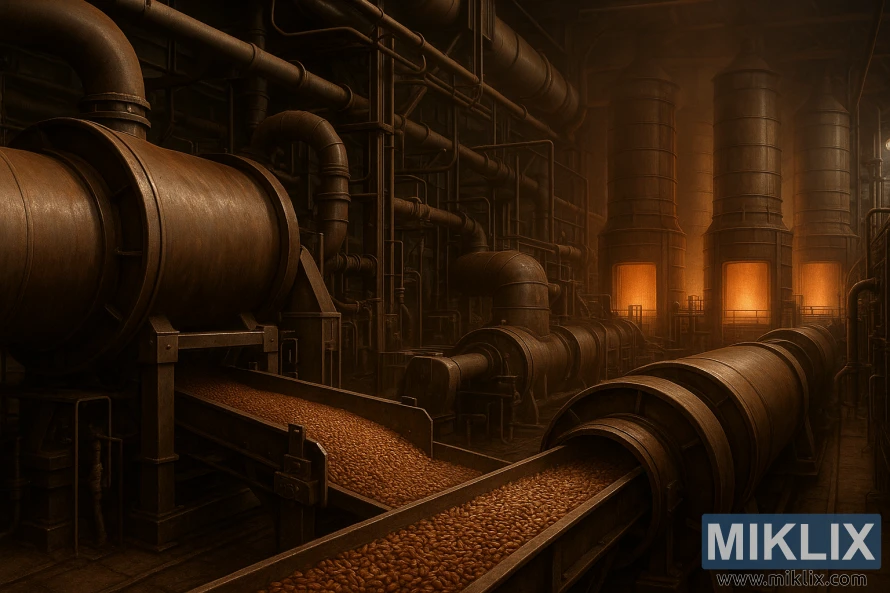
Chemical Composition and Properties
Brown malt stands out due to its complex chemical makeup, featuring a variety of flavor compounds. It is packed with nutrients like proteins, carbohydrates, and fiber, making it a key ingredient for brewers. The interaction of these compounds results in the unique flavors and aromas of brown malt, such as coffee, chocolate, and nut notes.
The malting process significantly influences brown malt's chemical composition. During this process, the grain germinates before being dried. This step activates enzymes that break down the grain's complex molecules into simpler forms. The malt then becomes rich in fermentable sugars, amino acids, and other nutrients vital for yeast growth and fermentation.
The flavor compounds in brown malt are both diverse and complex, adding to its distinctive character. These compounds include melanoidins, formed during malting and brewing, which are responsible for the malt's rich, malty flavors. Other compounds contribute to the beer's aroma through volatile molecules.
Brown malt's nutritional profile, with its proteins, carbohydrates, and fiber, makes it a nutritious ingredient. Brewers can use this to create beers with complex flavors and some nutritional benefits.
Comparing Brown Malt to Other Dark Malts
For brewers aiming to deepen their beers, grasping the unique flavors of brown malt, chocolate malt, and black malt is key. These malts, though classified as dark, each contributes distinct qualities to brewing.
Brown malt is celebrated for its nutty, toasted notes, enriching a variety of beer styles. Chocolate malt, with its deep cocoa flavors, is a staple in stouts, porters, and dark ales. Black malt, renowned for its robust, roasted taste, is used sparingly to imbue beers with a profound, roasted essence.
Here are some key differences between brown malt and other dark malts:
- Brown malt presents a more nuanced, complex taste compared to chocolate malt and black malt.
- Chocolate malt is sweeter and more intensely flavored than brown malt.
- Black malt is the most intensely roasted, boasting a bold, roasted flavor.
When deciding between brown malt, chocolate malt, and black malt, brewers must consider the desired flavor profile. By understanding each malt's unique traits, brewers can craft a wide array of complex, flavorful beers.
Some key considerations when comparing these malts include:
- The level of roastiness desired in the finished beer.
- The type of flavor notes desired, such as nutty, chocolatey, or roasted.
- The overall character of the beer, including its color, body, and mouthfeel.
By judiciously selecting and balancing different dark malts, brewers can create beers that are both complex and delectable.
Optimal Usage Rates in Different Beer Styles
Brown malt's unique character makes it a versatile ingredient, but its optimal usage rate differs by beer style. The amount of brown malt used can significantly impact the flavor profile of the final product.
In stouts and other dark beers, higher rates of brown malt are often used. This enhances the rich, complex flavors these styles are known for. The robust character of brown malt complements the roasted flavors, creating a deep and satisfying taste experience.
In contrast, pale ales and other lighter beers require more judicious use of brown malt. Lower usage rates are typically employed to add depth and complexity without overpowering the other ingredients. This subtle use of brown malt can enhance the overall character of the beer, adding layers of flavor that might be lacking.
- In stouts, brown malt can be used at rates up to 10% of the total grist.
- In pale ales, usage rates are typically below 5%.
- Porters and other dark ales often fall somewhere in between, with usage rates ranging from 5-8%.
Understanding these optimal usage rates is key for brewers looking to harness the full flavor of brown malt. By adjusting the amount of brown malt according to the specific beer style, brewers can achieve a more balanced and complex flavor profile.
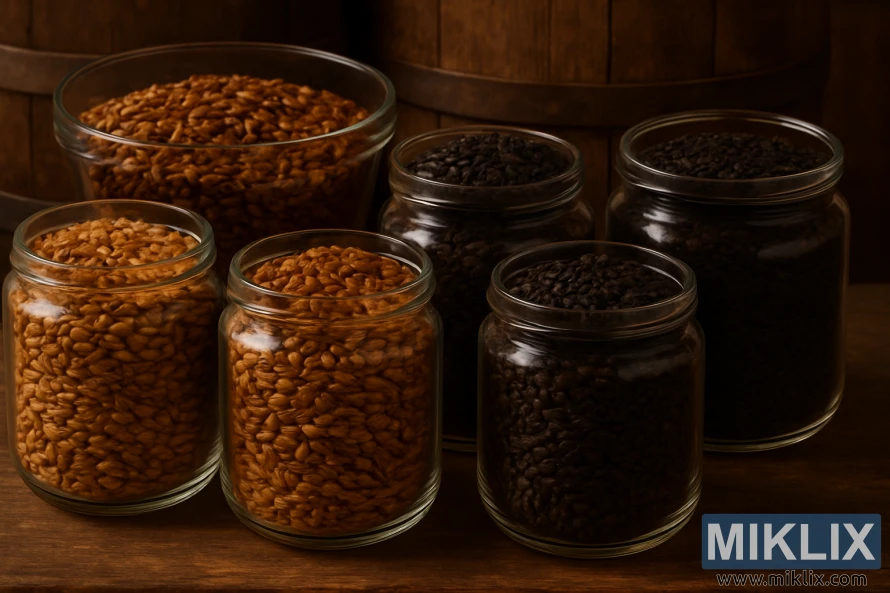
Impact on Mash Performance and Efficiency
Brown malt's unique characteristics are key to mash performance and extract yield. Its moderate diastatic power and extract yield make it ideal for brewers aiming to boost mash efficiency.
The diastatic power of brown malt is enough to convert starches into fermentable sugars. Yet, it prevents over-conversion, which could make the beer too dry or astringent. This balance is essential for achieving the desired beer profile.
Several factors are influenced by brown malt in mash performance:
- Enzyme activity: Brown malt's diastatic power aids in efficient starch conversion.
- Extract yield: The malt's extract yield impacts the brewing process's overall efficiency.
- Mash temperature: The optimal mash temperature may need adjustment when using brown malt.
Understanding brown malt's impact on mash performance helps brewers make informed decisions. This way, they can optimize their brewing processes and achieve the desired beer characteristics.
Classic Beer Styles Featuring Brown Malt
Traditional beer styles like porters and stouts owe their complex flavors to brown malt. This ingredient adds depth and richness to these beers.
Brown malt is a key ingredient in certain classic beer styles. Some examples include:
- Porters: Known for their dark color and robust flavors, porters often rely on brown malt for their characteristic taste.
- Stouts: Stouts, including dry stouts and imperial stouts, use brown malt to add complexity and depth to their flavor profiles.
- English Brown Ales: These ales utilize brown malt to create a nutty, malty flavor that is characteristic of the style.
The use of brown malt in these styles is not coincidental. Its unique flavor profile, which includes notes of coffee, toast, and nuts, is a perfect match for the robust flavors found in porters and stouts.
Breweries often adjust the rate of brown malt used to suit the specific style they are brewing. For example, a robust porter might use a higher percentage of brown malt to enhance the beer's complexity.
Recipe Formulation Guidelines
To unlock the full flavor of brown malt in brewing, a well-crafted recipe is vital. It begins with the grain bill. A recipe that incorporates brown malt must strike a balance between base malts, specialty malts, and hops. These elements should enhance its distinct taste.
The grain bill should blend base malts like pale malt or pilsner malt. These malts form the beer's fermentable sugar base. Specialty malts, such as crystal or caramel malts, add depth and complexity. Brown malt brings its own nutty, toasted notes.
When crafting a recipe, consider the right amount of brown malt. It usually makes up 5% to 15% of the grain bill. This depends on how strong you want the brown malt flavor to be. Hops should be chosen to complement the beer's complexity, with earthy, herbal varieties pairing well with brown malt.
- Choose base malts that provide a clean, neutral background flavor.
- Select specialty malts that complement the brown malt's flavor profile.
- Balance hop additions to enhance the beer's overall complexity.
By carefully crafting a recipe that showcases brown malt, brewers can create a variety of beer styles. Whether aiming for a traditional brown ale or exploring new recipes, the goal is to balance the grain bill and hop additions. This maximizes the brown malt's flavor contribution.
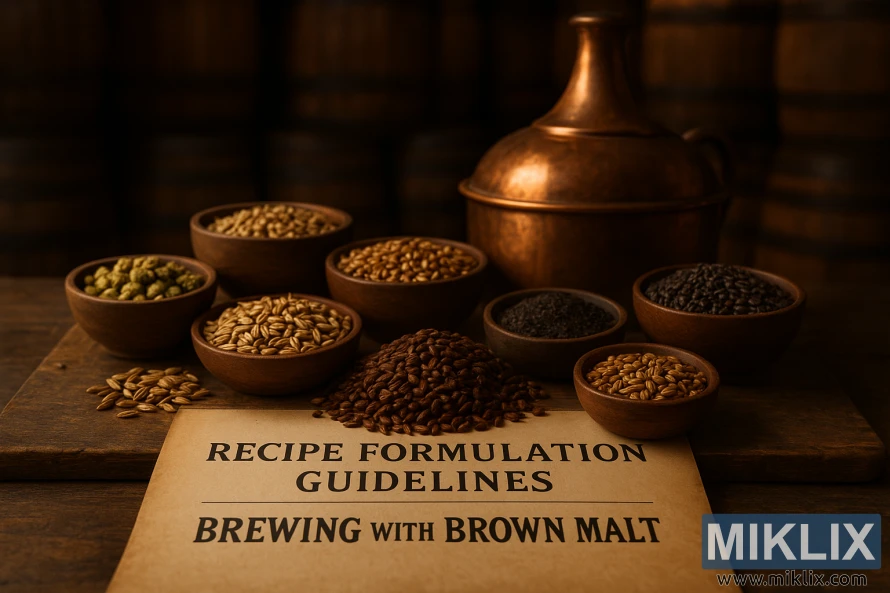
Common Brewing Challenges with Brown Malt
Brown malt, celebrated for its deep flavor and color, poses several brewing hurdles. Achieving the ideal balance of extraction is a major challenge brewers encounter.
Two common issues with brown malt brewing are over-extraction and under-extraction. Over-extraction results in a beer that's too dark or astringent, due to excessive extraction of malt's flavor and color. Under-extraction, conversely, leads to a beer lacking depth or appearing too pale, as not enough malt is utilized.
To overcome these challenges, brewers must adhere to certain guidelines. Here are some essential considerations:
- Monitor mash temperature closely to avoid over-extraction.
- Adjust the grain bill according to the desired beer style and strength.
- Be mindful of the water chemistry to ensure it complements the brown malt.
By grasping these challenges and employing suitable brewing methods, brewers can harness brown malt's full flavor. This enables the creation of high-quality beers with rich, complex profiles.
Water Chemistry Adjustments for Brown Malt Beers
The unique flavor and color of brown malt beers are significantly influenced by the brewer's water chemistry adjustments. Water chemistry plays a critical role in brewing. It affects the extraction of flavors and colors from the malts.
When brewing with brown malt, it's essential to adjust the water chemistry to optimize the beer's flavor and character. This involves adjusting the pH levels and mineral content of the water.
- Adjusting pH levels to the optimal range for mashing (typically between 5.2 and 5.5) ensures proper enzyme activity and extraction of the brown malt's flavors.
- Mineral content, such as calcium, magnesium, and sulfate, impacts the beer's flavor profile. For example, sulfates can enhance the beer's hoppy flavors, while calcium supports enzyme activity.
- The balance of these minerals should be considered in the context of the overall beer recipe, including the type of hops and yeast used.
Brewing water chemistry adjustments can significantly impact the final product's quality. By understanding and controlling these factors, brewers can produce high-quality brown malt beers with complex and balanced flavor profiles.
Fermentation Considerations and Yeast Selection
The unique traits of brown malt necessitate specific fermentation methods and yeast strains. To unveil their complex flavors and aromas, a thoughtful fermentation approach is essential.
When brewing with brown malt, the yeast selection is critical. It must ferment the malt's sugars effectively, aiming for a balanced and complex beer. Different yeast strains can either highlight or diminish certain flavors. Brewers must pick a yeast that enhances the desired taste.
For instance, yeast strains with high attenuation can dry out the beer's finish. Those with lower attenuation, on the other hand, can retain more residual sweetness. Controlling fermentation temperature is also key. It ensures the yeast works optimally, resulting in a full-bodied, flavorful beer.
- Choose a yeast strain that complements the flavor profile of the brown malt.
- Control fermentation temperatures to optimize yeast activity.
- Monitor fermentation progress to ensure the desired outcome.
By meticulously managing fermentation and selecting the right yeast, brewers can craft brown malt beers that truly showcase the malt's unique qualities. This dedication to detail can lead to a more complex and engaging drinking experience.
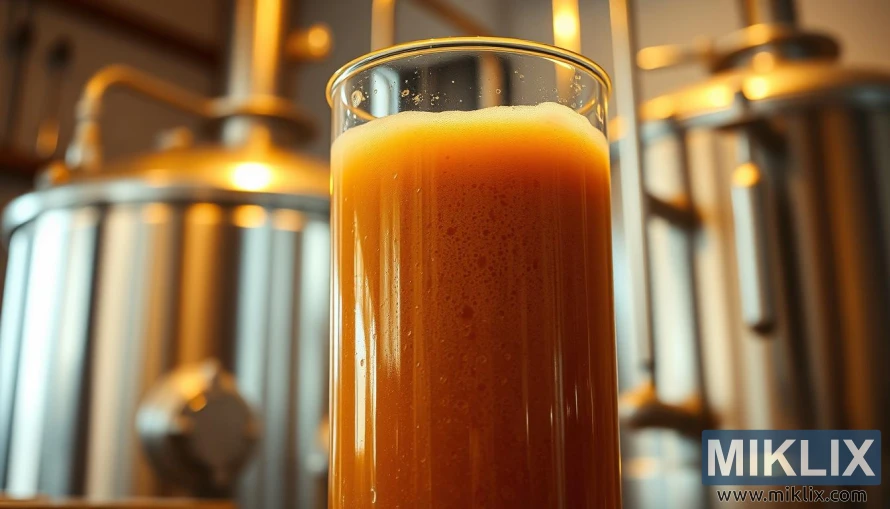
Storage and Handling Best Practices
To maintain the quality of brown malt, brewers must follow specific storage and handling guidelines. These practices are vital, as they directly impact the beer's flavor and character.
Brown malt should be kept in a cool, dry environment to preserve its taste and aroma. Moisture and heat can degrade its quality, causing off-flavors or staleness. It's also important to store it away from strong-smelling products, as it can easily absorb odors.
When handling brown malt, it's essential to avoid damaging the grain. Minimizing its exposure to air prevents oxidation and preserves flavor. Brewers should also ensure all equipment is clean and sanitized to prevent contamination.
Here are some key considerations for storing and handling brown malt:
- Store in a cool, dry environment.
- Minimize exposure to air to prevent oxidation.
- Keep away from strong-smelling products.
- Use clean and sanitized equipment when handling.
By adhering to these best practices, brewers can ensure their brown malt retains its unique qualities. This contributes positively to the final beer.
Troubleshooting Brown Malt Beer Problems
Addressing issues with brown malt beer requires a thorough examination of the brewing process and the beer's characteristics. Common problems include off-flavors and off-aromas. These can significantly impact the beer's quality.
To tackle these issues, brewers must first pinpoint the root cause. This might involve checking for contamination, assessing oxidation levels, or reviewing fermentation practices. Each step is critical in identifying the problem's source.
- Over-extraction during mashing can result in a bitter taste.
- Inadequate temperature control during fermentation can lead to unwanted flavors.
- Oxidation can introduce stale or cardboard notes into the beer.
To overcome these challenges, brewers can implement several strategies. Maintaining proper sanitation and handling practices can prevent contamination. Adjusting fermentation temperatures is also essential for achieving a cleaner flavor profile.
By understanding the causes of these common problems and taking corrective measures, brewers can create high-quality brown malt beers. These beers will highlight the unique characteristics of this specialty malt.
Conclusion
Brown malt is a versatile ingredient that adds depth and complexity to various beer styles. Its unique character, shaped by the production process, contributes to the flavor and aroma of the final product.
By understanding how to effectively use brown malt, brewers can craft balanced, full-bodied beers that showcase the ingredient's full range. From classic porters to modern American craft beers, brown malt is an essential component that enhances the brewing process.
In summary, the incorporation of brown malt in brewing opens up new possibilities for creating complex and flavorful beers. As brewers continue to experiment with this ingredient, they can develop innovative recipes that highlight its unique characteristics.
Further Reading
If you enjoyed this post, you may also like these suggestions:
